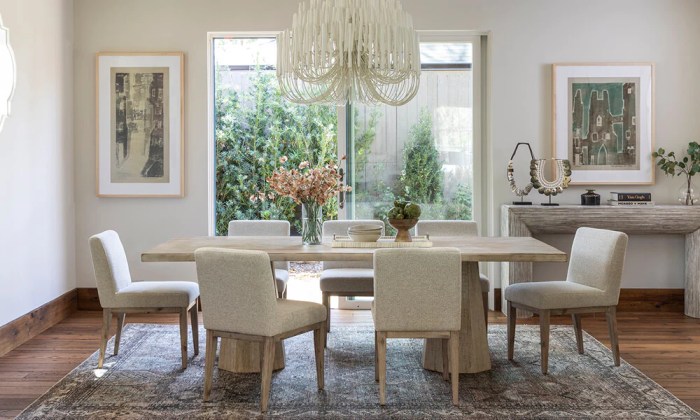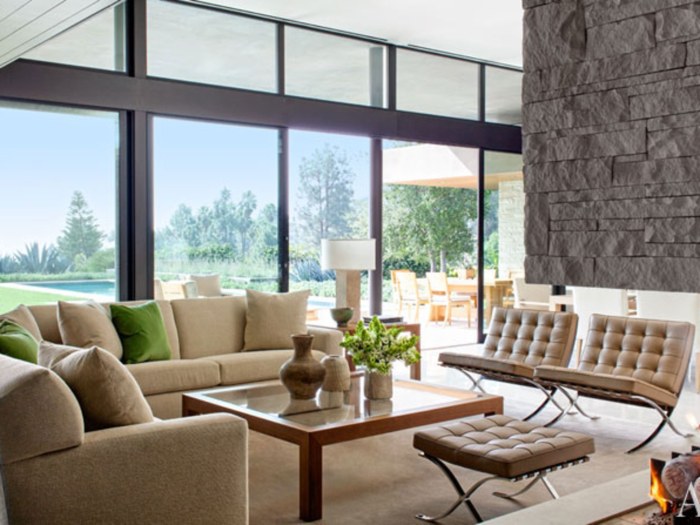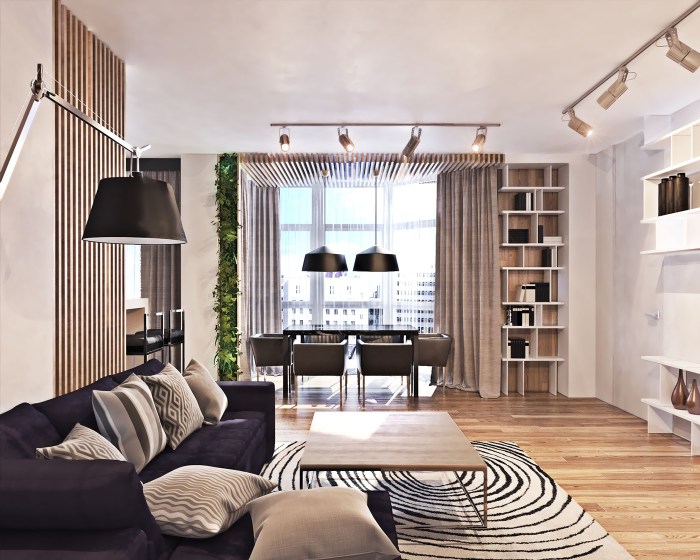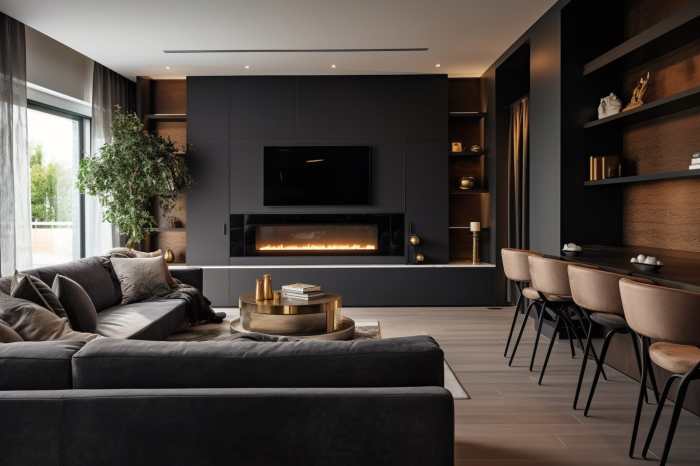Designing in a modern style requires understanding the nuances of both modern and contemporary aesthetics. This exploration delves into the core principles that define these styles, highlighting their key differences and showcasing how they can be seamlessly integrated into residential and commercial spaces. We’ll examine seven crucial elements that contribute to a truly contemporary design, offering practical guidance and inspiring examples.
From iconic furniture pieces to innovative material choices, we’ll cover a range of aspects, including color palettes, lighting schemes, and sustainable practices. The aim is to equip you with the knowledge and tools to create spaces that are not only visually stunning but also functional and environmentally responsible.
Defining Modern and Contemporary Design Styles

Modern and contemporary design, while often used interchangeably, represent distinct aesthetic movements with unique historical contexts and characteristic features. Understanding their differences is crucial for appreciating the nuances of each style and applying their principles effectively in design projects. This section will explore the defining characteristics of both styles, providing examples and a visual representation to highlight their key differences.
Modern design, also known as Modernism, emerged in the early 20th century as a reaction against the ornate styles of the Victorian era. It emphasized functionality, clean lines, and a rejection of superfluous ornamentation. Contemporary design, on the other hand, encompasses the trends and styles prevalent from the 1970s to the present day, representing a more fluid and eclectic approach. While sharing some common ground with Modernism, contemporary design embraces a broader range of materials, techniques, and influences.
Modern Design Characteristics and Examples
Modern design is characterized by its minimalist aesthetic, emphasizing functionality and clean lines. The use of industrial materials like steel and glass is prominent, along with a preference for geometric shapes and a neutral color palette. Iconic examples include the Barcelona chair by Mies van der Rohe, with its sleek chrome frame and leather cushions, and the Bauhaus architecture exemplified by the Gropius House, showcasing simple geometric forms and an integration of indoor and outdoor spaces. The rejection of ornamentation and the focus on functionality are central tenets.
Contemporary Design Characteristics and Examples
Contemporary design, unlike its Modernist predecessor, is less defined by a single set of rules and more by a spirit of experimentation and eclecticism. It incorporates elements from various historical periods and cultural influences, resulting in a diverse range of styles. Materials are varied, including natural materials like wood and stone alongside modern synthetics. Color palettes can be bold and vibrant or muted and sophisticated. Examples include the Eames Lounge Chair and Ottoman, showcasing molded plywood and a sophisticated silhouette, and the Zaha Hadid architecture, known for its fluid, dynamic forms and innovative use of materials. The key is adaptability and a response to current trends.
Mood Board: Modern vs. Contemporary Design
Imagine a mood board divided into two sections. The “Modern” section features a grayscale image of a minimalist apartment with clean lines and geometric furniture, possibly a simple white sofa and a glass coffee table. The color palette is muted, consisting of grays, whites, and blacks. The overall feeling is one of order, simplicity, and functionality. The “Contemporary” section, in contrast, displays a collage of images showcasing diverse textures and materials. There might be a picture of a brightly colored, organically shaped sofa, a textured rug, and a piece of modern art with bold colors and abstract forms. The color palette is more varied, possibly including rich jewel tones and bright accents. The overall feeling is eclectic, vibrant, and expressive.
Historical Context and Evolution of Modern and Contemporary Design
Modern design’s roots lie in the early 20th-century reaction against historical styles. The Bauhaus school in Germany played a pivotal role, emphasizing functionality and the integration of art, craft, and technology. Post-World War II, Modernism spread globally, influencing architecture, furniture design, and graphic design. Contemporary design emerged from the latter half of the 20th century, building upon Modernist principles but incorporating new technologies, materials, and cultural influences. Postmodernism, with its playful rejection of Modernist austerity, significantly shaped contemporary design, leading to the diverse and eclectic styles we see today. The ongoing evolution reflects our ever-changing society and technological advancements.
Seven Key Elements of Contemporary Design

Contemporary design, characterized by its clean lines, minimalist aesthetic, and functional approach, relies on a careful selection of key elements to achieve its signature look and feel. These elements work in harmony to create spaces that are both visually appealing and highly practical. Understanding these core principles is crucial for anyone aiming to design in a modern style.
Clean Lines and Minimalist Forms
Clean lines and minimalist forms are foundational to contemporary design. This means avoiding excessive ornamentation or overly complex shapes. Instead, the focus is on simple, geometric forms and straight lines, creating a sense of order and spaciousness. This approach is evident in furniture with uncluttered silhouettes, architectural features with sharp angles, and the absence of fussy detailing. The impact is a feeling of calm and sophistication.
Neutral Color Palettes
Contemporary design often favors a neutral color palette as a backdrop. This usually incorporates shades of white, gray, beige, and black, allowing other elements, such as textures and pops of color, to stand out. These neutral tones provide a sense of serenity and allow for flexibility in incorporating accent colors and patterns without overwhelming the space. Think of a calming gray living room, punctuated by vibrant artwork or textured throws.
Natural Light and Open Spaces
Maximizing natural light is a key element in contemporary design. Large windows, skylights, and open floor plans are commonly used to flood spaces with natural light, creating a bright and airy atmosphere. Open spaces enhance the sense of spaciousness and fluidity, allowing for a seamless transition between different areas of a home or office. This contributes to a feeling of openness and freedom.
Natural Materials
The use of natural materials is another defining characteristic. Materials such as wood, stone, concrete, and glass are frequently incorporated to bring a sense of warmth and authenticity to the space. These materials, often left in their natural state or minimally processed, contribute to a feeling of connection with the natural world and add textural interest. For example, a concrete floor paired with wood accents creates a beautiful contrast.
Functionality and Purpose
Contemporary design prioritizes functionality. Every element within a space should serve a purpose, avoiding unnecessary clutter or ornamentation. Furniture is chosen for its practicality and ease of use, and storage solutions are integrated seamlessly into the design. This emphasis on functionality contributes to a sense of efficiency and order.
Technology Integration
Contemporary design seamlessly integrates technology into the living space. Smart home systems, hidden wiring, and integrated audio-visual components are incorporated discreetly to enhance convenience and functionality without compromising the aesthetic appeal. This approach reflects the modern lifestyle’s reliance on technology.
Textural Contrast
Contemporary design expertly uses textural contrast to add visual interest and depth. Combining different textures, such as smooth glass with rough-hewn wood or soft fabrics with polished metal, creates a dynamic and engaging space. This contrast prevents the minimalist aesthetic from feeling too stark or sterile. For instance, a sleek glass coffee table might be placed on a plush, textured rug.
Application of Elements: Residential vs. Commercial Spaces
| Element | Residential Application | Commercial Application |
|---|---|---|
| Clean Lines & Minimalist Forms | Simple furniture, uncluttered spaces, minimalist kitchen design | Streamlined office layouts, minimalist retail displays, clean architectural details |
| Neutral Color Palettes | Calming bedroom with neutral walls, a living room with beige accents | Neutral office walls to create a calm work environment, neutral retail spaces to highlight products |
| Natural Light & Open Spaces | Large windows in living areas, open-plan kitchen-dining areas | Large windows in offices, open-plan office layouts, light-filled retail spaces |
| Natural Materials | Wooden floors, stone countertops, exposed brick walls | Wood paneling in reception areas, stone flooring in lobbies, concrete accents in modern offices |
| Functionality & Purpose | Multifunctional furniture, built-in storage, efficient kitchen layouts | Ergonomic workstations, efficient office layouts, well-organized retail displays |
| Technology Integration | Smart home systems, integrated lighting, hidden wiring | Smart office systems, integrated audio-visual equipment, high-speed internet access |
| Textural Contrast | Soft rugs against hardwood floors, smooth countertops against textured backsplashes | Textured wall coverings combined with sleek furniture, contrasting materials in retail displays |
Incorporating Seven Elements into a Design Project: A Step-by-Step Guide
Before beginning, establish a clear understanding of the project’s purpose and desired atmosphere. Consider the space’s function and the intended users.
- Define the Space’s Purpose and Desired Aesthetic: Determine the primary function of the space and the overall mood you wish to create (e.g., calming, energetic, sophisticated).
- Create a Mood Board: Gather images, color swatches, and material samples that reflect your chosen aesthetic and the seven elements. This visual guide will help you maintain consistency.
- Develop a Color Palette: Select a neutral base and incorporate accent colors strategically to highlight specific features or add personality.
- Choose Materials: Select natural materials such as wood, stone, or concrete, balancing them with other materials for textural contrast. Consider durability and maintenance requirements.
- Plan the Layout: Design a functional and efficient layout, maximizing natural light and creating a sense of flow. Prioritize open spaces where appropriate.
- Select Furniture and Fixtures: Choose furniture and fixtures that are both functional and aesthetically pleasing, adhering to the clean lines and minimalist forms of contemporary design.
- Integrate Technology: Plan for seamless technology integration, ensuring that smart home systems and other technologies are incorporated discreetly and efficiently.
- Add Textural Elements: Introduce textures through rugs, throws, cushions, and wall coverings to add visual interest and depth without compromising the overall minimalist aesthetic.
Practical Application and Creative Exploration

Applying the seven elements of contemporary design—clean lines, minimalism, functionality, natural light, neutral color palettes, sustainable materials, and a focus on texture—transforms theoretical concepts into tangible, aesthetically pleasing, and functional spaces. This section explores the practical application of these principles through a case study of a modern living room design and examines the influence of color palettes, lighting, textures, and sustainable practices.
Modern Living Room Design Incorporating Seven Elements
To illustrate the practical application of these design elements, consider a modern living room. The space features clean lines achieved through the use of a minimalist sofa with a low profile and straight lines, paired with a sleek, rectangular coffee table. Functionality is maximized with built-in shelving units that seamlessly integrate storage and display. Large windows maximize natural light, flooding the room with brightness. The color palette centers around soft greys and whites, accented with natural wood tones for warmth. Sustainable bamboo flooring provides both durability and an eco-friendly choice. Finally, textural interest is introduced through a plush wool rug, the woven texture of the bamboo flooring, and the smooth surfaces of the minimalist furniture. The overall effect is a calm, sophisticated, and functional space.
Influence of Color Palettes and Lighting Schemes
Color palettes and lighting significantly impact the perception of modern design. A predominantly neutral palette, such as greys, whites, and beiges, creates a sense of spaciousness and serenity, characteristic of modern aesthetics. Strategic use of accent colors—perhaps a deep teal in throw pillows or a vibrant yellow in artwork—adds visual interest without disrupting the overall sense of calm. Similarly, lighting plays a crucial role. Natural light is prioritized, but supplementary lighting is strategically placed to highlight architectural features and create ambiance. Recessed lighting provides even illumination, while task lighting—such as a floor lamp beside a reading chair—offers focused light. A dimmer switch allows for adjusting the intensity and mood of the lighting to suit different activities and times of day. For example, warm, low lighting in the evening creates a relaxing atmosphere, while bright, cool lighting during the day enhances productivity.
Use of Textures and Materials to Create Visual Interest and Depth
The strategic use of diverse textures and materials is key to creating visual interest and depth in a modern design. Mixing smooth surfaces, like those of a glass coffee table or a polished concrete floor, with rougher textures, such as a woven rug or a textured throw blanket, adds complexity and visual richness. The contrast between materials like natural wood and brushed steel can further enhance the visual appeal. For example, the smooth, cool surface of a marble coffee table can be contrasted with the warm, organic texture of a wooden side table, creating a dynamic interplay of textures. This layered approach prevents the space from feeling monotonous and adds a sense of sophistication.
Integration of Sustainable and Eco-Friendly Practices
Sustainability is increasingly integrated into modern design principles. Choosing materials with low environmental impact, such as reclaimed wood, bamboo, or recycled glass, minimizes the carbon footprint of the design. Prioritizing energy-efficient lighting, such as LED bulbs, and incorporating natural ventilation reduce energy consumption. Furthermore, selecting furniture made from sustainably sourced materials and opting for durable, long-lasting pieces minimizes the need for frequent replacements, reducing waste. For instance, choosing furniture made from sustainably harvested wood, like FSC-certified teak, demonstrates commitment to responsible forestry. Similarly, the use of low-VOC (volatile organic compounds) paints and finishes reduces the release of harmful chemicals into the indoor environment.
Last Word

By understanding the seven key elements of contemporary design and their application across different settings, you can confidently embark on your own design projects. Remember that modern design is an evolution, a blend of functionality and aesthetics, constantly adapting to new trends and technologies. Embrace experimentation, explore diverse materials, and let your creativity guide you in crafting unique and inspiring spaces.